Buying a First Glove
2022-01-02
Whether you are looking for a child's first baseball glove, or replacing one that's worn out or outgrown, there are choices to make that can have a big influence on the player's performance, success, and ultimately, his fun.
Buying a First Glove
The first glove is perhaps the most important piece of equipment a player will ever own. Why? It's his first connection to the game, and a glove that works well for him will help him play his best.
The key to that beginner's glove is control. He must be able to move the glove quickly to the ball, which requires a glove that's not too big and heavy for him. He must be able to close the glove with his hand, so that the ball does not pop out. This requires a glove that is soft and pliable enough when purchased, or after a very short break-in, that he can close the pocket and 'squeeze' the ball. And it requires a glove that is comfortable and fits his hand well, so he's not constantly fooling around with it in the field.
We recommend a glove that is in proportion to the player's size. We've seen T-ballers, all of four feet tall, lugging around huge 13-inch outfielder's gloves. The parent thought it would help them catch more balls, but the truth is, it is a huge handicap as they have no glove control. They'd do better barehanded than with that leather mattress on their little paw!
As youth sizes begin around the nine-inch pattern range (the measurement is from the bottom of the heel of the glove to the top of the longest finger or webbing), there is a proper glove for every kid. The new generation of pre-oiled gloves are usually excellent, as they are very supple and require little or no break-in. For a very small child, or one with less strength than his peers, you can look into some of the vinyl, or combination vinyl-and-leather models. These are very inexpensive and, while they will not last as long as higher quality gloves, they bend easily and allow the player to catch the ball from day one. There are also full leather gloves in the under-11 inch size, which cost more, last longer, and might require some break-in.
Some new models even have a notch designed into the heel of the glove to allow easy and immediate flexing of the pocket.
Beware of small (11 or 111/2 inch) professional model infielder's gloves. Professional shortstops and second basemen use small gloves, which can be mistaken for youth models, except for their high price. These are usually a very good, durable, and stiffer hide, which requires break-in even for the bigger guys and pros, and will never break in sufficiently for a beginner. As much as you want to buy the best for your kid, avoid the expensive, stiff gloves for players under 10 or so. They'd have to play eight hours a day, seven days a week, for six months before it was broken in. And in that time, they'd make so many errors that they'd be shopping for soccer cleats by then!
Replacement Glove
As the player advances up the ladder, he may outgrow his glove, or it may be worn out. A good quality leather glove, if it still fits him and he plays well with it, is worth having repaired. New lacing, webbing, patching, and any other repair can be carried out by specialists.
If it's time for a new one, however, there are again a lot of choices. Is the player significantly larger than he was when he got his first glove? Is he playing outfield or infield more?
There are four basic glove types: infield, outfield, first baseman, and catcher. Most youth players are not yet specialized enough to invest in a first baseman's mitt, and their regular glove will suffice for duty at the first bag. Catcher's mitts are supplied by the league.
For a youth playing different positions, a good range of fielder's gloves would be the 11-1/2 to 12-inchers. These are not too unwieldy for the quicker moves required in the infield, yet offer enough 'reach' in the outfield. As the glove increases by half-inch increments, its overall dimension increases geometrically, and weight increases as well.
At this stage, a higher quality glove is a good investment. Again, fit is crucial, and if it doesn't feel good in the store, it's not going to get much better after break-in. Sort of like buying a pair of shoes. Gloves in the $50 to $100 range include just about every style, size, and quality level you'll need. We'd avoid any gloves constructed with vinyl, and it's up to you if you want to spend upwards of $200 or more for the top, premium 'pro' gloves.
For a player who logs most of his time in the infield, stick to the smaller 11 or 11-12 inch gloves. A pre-formed pocket is preferred, deeper for third base and shortstop, shallower for second base (although this sort of specialization at the youth level is not recommended). The outfielders have a larger selection, it seems, with a huge selection of 12 to 12-1/2 inch models. Anything larger than 12-1/2 inch is too much glove, generally, unless he plans to play softball!
